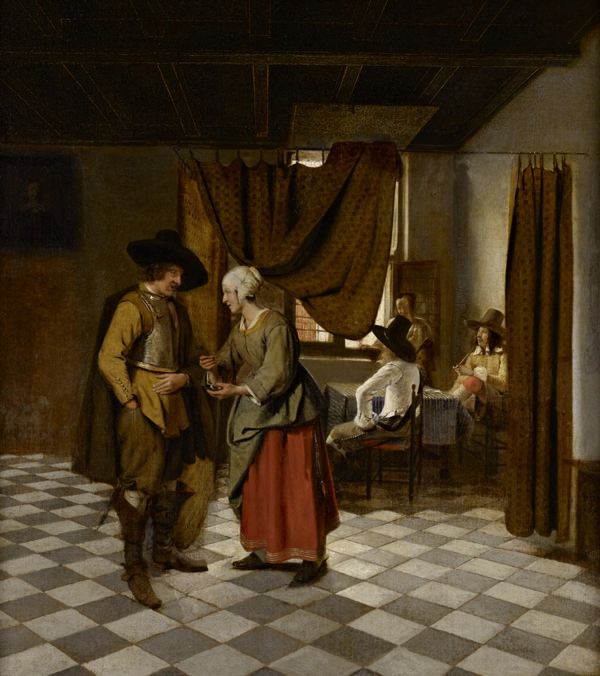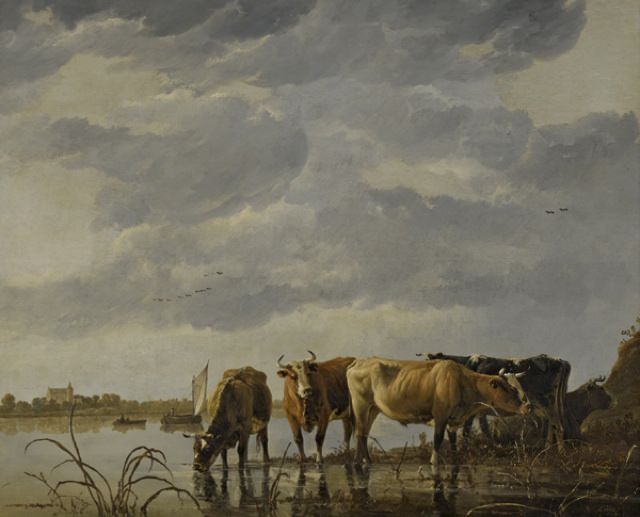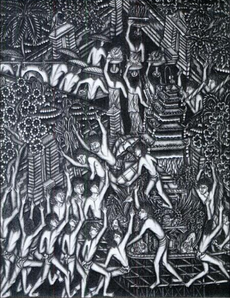“If a book is really good, it will reach out to everyone, the world over,” one of the directors of the Edinburgh Book Festival tells me. We’re attending a reception at the National Gallery of Scotland to celebrate a loan of nineteen Dutch paintings from the seventeenth century, housed for many years in glorious isolation in a stately home on the Isle of Bute, along with the publication of Dutch writer Herman Koch’s new novel, The Dinner. The director has been talking to me about the festival’s determination to bring foreign authors to Edinburgh—because the best writing should be available everywhere.
“It’s interesting,” I tell her, “that this belief in the universal appeal of fine literature exactly coincides with commercial convenience. The better a book is, the more it transcends its local origins, the more people it can be sold to worldwide.” Put like that, she feels, the position sounds cynical, yet she sincerely believes, and her experience confirms, that the best literary work always does transcend borders.
“The other advantage of this approach”—I go on playing devil’s advocate, unwisely, since I was one of the authors invited to the festival—“is that we never need feel anxious or frustrated that we might be missing out on some truly great work of art because we don’t really know the culture that produced it: if the work were really great, it would, by definition, reach out to us; if it doesn’t, it’s not worth our, nor anyone else’s attention. Basically, I can feel confident that I am the arbiter of everything.”
At this point, and it’s probably just as well, our conversation is interrupted by the evening’s scheduled proceedings: the Consul for the Netherlands speaks briefly of the Earl of Bute’s remarkable art collection and the nineteen Dutch masters on loan to the Scottish gallery; Herman Koch’s publisher and then Koch himself say a few words about his novel, but really so few that he’s hardly started before he’s finished. All I can gather is that the book takes place at a dinner party where two Dutch families discuss an outrage committed by their sons and find themselves obliged to choose between protecting their children and remaining true to their humanitarian beliefs.
After the talking, people drift off to visit the paintings, which feature a number of artists, in particular Aelbert Cuyp, who was hugely popular with British collectors in the 18th century. Cuyp’s paintings are rather melancholy, sentimental, quietly elegant representations of cattle in watery landscapes, perhaps with a child cowherd adding a touch of pathos, images that do not appear to require any special knowledge or expertise to decipher.
Other works, apparently less popular among foreign collectors include far more local and particularly social detail. The Disputed Reckoning by Pieter de Hooch shows a behatted man in animated conversation with a drably dressed woman. It takes me a few moments to remember that reckoning is an old word for bill, like the German Rechnung: We have two people arguing about cash. That shifts things a little. No doubt if I were more familiar with Dutch mores in the 17th century the clothes and the ambience might tell me more, or perhaps even raise a smile.
And all the time I’m looking at the pictures I’m trying to figure out the implications of this idea that important art always travels. One consequence must be that, however deeply a work is immersed in the local and contemporary—like de Hooch’s painting of this quarrel over a bill, a hotel bill I’m beginning to think now—recognition of local detail is not essential for appreciating what really matters, which in this case must be the falling out over money of two people, a man and woman, their bodies animated, the woman raising a hand as she leans aggressively toward the man who has his right hand in his pocket, perhaps feeling for coins—assuming people kept coins in their pockets, in Holland, in those times.
The universalist approach, that is, invites us to extrapolate or identify some easily communicable, generic element—unequal power relationships, existential anxieties, or some key idea central to all human life—and tells us that this is what matters about the work of art, not the nature of its engagement with its culture of origin, with the colors of the rooms, the furnishings, the things people wore, or habitual body postures of the time. So in Koch’s novel we would be dwelling on the inevitable tension between family loyalty and respect for society’s rule of law, or for humanitarian ideals—something understandable all over the world—rather than savoring, from within the experience of Dutch culture, exactly where these families were coming from, how they recall or don’t recall things Dutch readers recognize in their Dutch lives.
Advertisement
But what if the quality of some fine works of art is exactly in their relationship with the local and the contemporary, with the life that it has been given to them to experience here and now? I’m reminded of a telling moment at a conference in 2005 to celebrate the hundredth anniversary of the birth of Henry Green, a novelist who never enjoyed more than a small following, but whose admirers nevertheless tend to make great claims for him, as if the intensity of their enthusiasm had to make up for the author’s failure to become a truly major name, or an international figure (for sure, Green’s prose does not translate easily).
Invited to give the keynote speech, James Wood kicked off by asking the question, Why did Green remain, for all our affection for him, a minor rather than a major author? This notion caused some consternation among the adoring crowd. Wood went on to conclude that Green’s novels, all intensely focused on carefully circumscribed and intensely observed milieu (the servants in a wealthy household in Ireland in the First War, a group of spoiled rich people on their way to France caught in a fog in Victoria Station, a middle-class London couple and their small circle of friends in the 1950s) had never posited or dramatized grand moral issues, in the way works by, say, Tolstoy, Dickens, Faulkner, or indeed any “great” novelist, do.
My heart rebelled. Of course Wood was perfectly right: Green didn’t pose—or seem remotely interested in posing—grand moral questions. Yet I knew that Green, whatever his national or international reputation, was not minor for me; on the contrary his work had been absolutely central to forming my sense of the pleasures that might be had from literature. His eccentric mix of empathetic observation, perfect mimicry, but also strangely distorting, sometimes surreal, often hilarious description and commentary, always enchanted me, conveying an urgency of engagement and a subtle complicity that seemed in no way provincial but that required at least some knowledge of the milieu to appreciate. And in these books, you could not set this aspect aside to extrapolate some universal quality, either at the level of a normally satisfying plot, or a philosophical reflection.
Another example of an author in this position might be Barbara Pym, particularly in a late work like A Few Green Leaves, where the characters, not one of whom is granted so much as a hint of charisma, allow the great intensities of life to pass them by, taking refuge in, but also suffocated by, the warm wet blanket of social routine in an English village parish. Pym enjoyed a vogue in the United States in the 1980s when she was perceived as a purveyor of English quaintness; yet for an English person reading her fiction, there was nothing quaint about it, rather an invitation to accept that however trivial, a fondness for social minutiae can offer a consolation, or at least a hiding place, when existential winds blow cold.
But again, to engage with this and respond to Pym’s wry genius, some familiarity with the milieu is required. I cannot imagine getting the same pleasure from, say, a Burmese Barbara Pym, or even a Spanish Barbara Pym, if such figures were to exist. But I believe Pym and Green to be finer writers than many a worthy Nobel taking in the grand questions of the century. In this regard, it’s interesting that Alfred Nobel’s will stipulated that the winner of his international literature prize must show “outstanding work in an ideal direction,” a characteristic, that is, that could be abstracted from the local, the life we actually live in.
I believe this whole approach is limiting and risks obscuring how literature is actually experienced and how it can indeed act positively in our lives, without playing out great moral dramas or drawing us toward weighty opinions or intense emotions. In Steps To an Ecology of Mind, discussing a Balinese painting depicting a cremation procession, the British anthropologist Gregory Bateson remarked that you might think the painting was about funeral rituals, or that it portrayed a Balinese tendency to combine grief with gaiety, or alternatively you might notice that by introducing a very large cremation tower that must pass through a narrow entrance the artist had introduced a bizarre phallic symbol. In fact, Bateson concludes, the more you looked, the more the painting seemed to be an invitation to contemplate the possible relatedness of all these elements and indeed the manner of drawing and coloring in which they were all brought together. The overall effect, he thought, was not to say anything about any of the elements but to draw the mind to a contemplative state where the desire for easy meaning and the consequent purposefulness that comes with believing you have understood something was thwarted by a beautiful complexity, or rather a recognition that life is beautifully complex, beyond easy rational apprehension. Engagement with art, whether it is such a painting, or the interrelatedness of characters and environment in a novel, or the interplay of motifs in music, had the effect of countering what Bateson saw as our dangerous yearning to arrive at a crude understanding of the world and then intervene.
Advertisement
As Bateson saw it then, the depiction of grand ideals was not necessary to make art that might have a positive influence; on the other hand, an intimate knowledge of the local gave author and audience a chance for a more intense experience of connections, complications, and mysteries. International recognition of this or that hugely superior work of art was not important, nor was a discussion of its supposed ideas; what counted, on the contrary, was a frequent, ongoing experience of art, something that might correct our normally reductive and rapacious ways of thinking.
Let me close by proposing this little experiment. Choose any “great” novel, no more than a century old, from your own home culture; in fact, the nearer to home the better; get on the net and check with a couple of critics what major issues the book articulates, and what profound thoughts make it worthy of the international recognition it enjoys. Then try reading it. A hundred to one the simplicities and dogmatisms of criticism will dissolve in a richness of voice and elusive ethos that is constructed from all the different elements of the culture the writer is bringing together. What you actually experience line by line as the book connects with so much you already know, rearranging it in new ways, or sparking recognitions set off by novelties, is not something that can easily be articulated, or that a foreigner reading the same book in translation will necessarily get.
After a while it may even seem as if those elements that raised the book to its special status are quite incidental to its real performance, almost an alibi that allowed the work to circulate in a politically correct environment. This was certainly my experience a couple of years ago when I started rereading Thomas Hardy; there is so much more in the texture of his writing, the liveliness of his dialogue playing off against the absorption in landscape, than in any of the famed discussions of fate and destiny. It would be a great shame if we were to lose this intense experience of reading for a product with “an ideal direction” that can more easily be discussed among international audiences in literary festivals.
“Masterpieces from Mount Stuart,”an exhibition of Dutch, Flemish, early Netherlandish, and French paintings from the Bute Collection, is on view at the Scottish National Gallery in Edinburgh through December 2.





